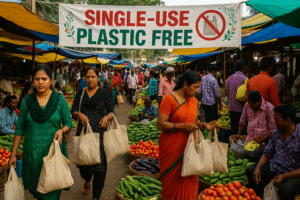Fun fact: some fast-growing plantation monocultures can actually store less carbon than the natural forests they replace — and they often kill off biodiversity in the process.
Welcome to “The Green Cover Scam” — a scandal hidden behind shiny tree-planting campaigns. On the surface, it feels noble: more green cover, cleaner air, climate rescue. But dig deeper, and many of these “plant drives” are replacing rich, layered forests with single-species tree farms. The result? A biodiversity disaster dressed up as climate action.
The Allure of “Green Cover” — and Why It’s a Dangerous Illusion
We all want a greener planet. So when governments, corporations, or NGOs promise millions of trees, it resonates emotionally. Who could oppose more trees? The problem is this: the narrative often collapses complexity into a slogan.
When “forest cover” is measured by hectares of any tree canopy, you get perverse incentives: plant fast-growing monocultures (like eucalyptus, acacia, pine), count them as forests, and call it a win. But a plantation of identical trees is not a forest. It lacks undergrowth, soil microbes, insects, birds, and the complex web of interactions that make forests resilient.
In many official reports, “forest area” includes plantations. This blurs the line between genuine restoration and greenwashing. The Green Cover Scam is essentially this sleight of hand: counting tree farms as forests and hiding ecological loss behind a veneer of green.
How the Scam Works: Tricks, Trade-offs, and False Promises
Carbon Accounting Illusions
Tree planting is marketed as a carbon offset: burn carbon, then “neutralize” by planting. But plantations are often harvested quickly, releasing stored carbon; soils are disturbed; native vegetation is destroyed. Many global “forest restoration” pledges end up being monoculture plantations rather than biodiverse forests.
Impeding Ecological Recovery
Monocultures don’t just fail to restore — they actively block recovery. Studies show that monocultural plantations can impede natural regeneration for decades, preventing native ecosystems from returning.
Social and Land Justice Issues
“Green grabbing” is common: land converted under the pretence of environmental projects, with local communities displaced or denied access to their commons. The voices of people who live with and depend on these ecosystems are often excluded from decision-making.
Real Pain in Real Places
India’s Fast-Growing Species
Eucalyptus, acacia, rubber, and teak are popular in India for quick results. But these species lower groundwater, suppress undergrowth, and reduce habitat for native wildlife. Several states have witnessed reduced soil fertility and disrupted local ecology due to such monoculture plantations.
China’s Massive Programs
China’s “Grain for Green” program has been praised for controlling soil erosion. But many of the forests planted are conifer monocultures — poor in biodiversity, fragile against pests and fires, and less effective at long-term carbon storage.

Southeast Asia’s Palm Oil Plantations
Palm oil monocultures in Indonesia and Malaysia are among the most extreme cases: entire biodiverse rainforests are cleared for a single species. The result is catastrophic biodiversity loss, with dramatic declines in bird, insect, and mammal populations.
Positive Models
Not all is bleak. Projects like the Aravali Biodiversity Park in Gurgaon, India, show how native species restoration can work. By removing invasive plants and introducing native vegetation, the park now supports hundreds of bird species and other wildlife. Community-led projects like this show the right path forward.
Why Monocultures Fail as Solutions
Carbon Storage is Overrated – Natural forests lock carbon in roots, soils, and diverse biomass for centuries; monocultures often fail.
Fragility of Uniformity – Single-species plantations collapse under pests or droughts.
Biodiversity Loss – Birds, pollinators, fungi, and understory plants vanish in monocultures.
Hydrology and Soil Damage – Many fast-growing trees dry out streams and erode soil.
Social Injustice – Communities lose forest resources, rights, and livelihoods.
Greenwashing Narratives – Big “tree count” targets distract from real conservation.
What Real Restoration Looks Like
Native, Mixed-Species Planting – Mimicking natural ecosystems.
Natural Regeneration – Protecting soils and letting nature regrow.
Agroforestry and Mosaic Landscapes – Integrating biodiversity with agriculture.
Community-Led Design – Local knowledge and rights matter.
Long-Term Accountability – Restoration judged over decades, not just project cycles.
Conclusion
The Green Cover Scam is a betrayal of nature dressed in green uniforms. Planting a million identical trees may look like climate action, but it often destroys life instead of restoring it.
It’s not that tree planting is bad — but how we do it matters. We must stop being dazzled by photo-ops and demand real restoration: diverse, native, community-driven, and lasting.
The next time you hear of a “mega plantation drive,” ask: which trees? whose land? Who benefits? And will it restore the web of life — or just create a lifeless green desert?
Author’s Note
I wrote this because I believe our climate fight cannot be built on false promises. The Green Cover Scam shows how easy it is to twist good intentions into ecological disasters. I hope this piece makes you pause, question, and demand better.
G.C., Ecosociosphere contributor.
References and Further Reading
- Monoculture Tree Plantations Are “Green Deserts” – Mongabay
- Mixed-Species vs. Monocultures in Plantation Forestry – ScienceDirect
- Why Green Pledges Will Not Create the Natural Forests We Need – Yale E360
- Monoculture Plantations Impede Forest Recovery – Frontiers in Forests and Global Change
- Forest Cover and Plantation Accounting – Global Forest Coalition
- Green Grabbing: Appropriation of Land for Environmental Projects – Wikipedia




